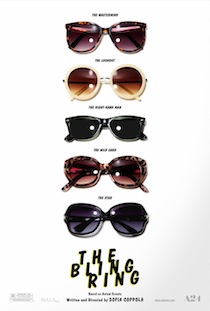 Writer and Director Sofia Coppola never shies away from tough subject matter. Whether it is the group suicide of teenage sisters, emotional and physical philandering, loveless marriages, estranged children, Sofia Coppola has a quiet stoicism in her direction that gives the bite of reality to each of these subjects.
Writer and Director Sofia Coppola never shies away from tough subject matter. Whether it is the group suicide of teenage sisters, emotional and physical philandering, loveless marriages, estranged children, Sofia Coppola has a quiet stoicism in her direction that gives the bite of reality to each of these subjects.
Her latest film, The Bling Ring is a character study of a specific culture. Based on “The Suspects Wore Louboutins,” The Bling Ring follows a small and affluent clique of teens who have grown up in the shadow of Hollywood splendor.
Influenced by her own malaise and the constant media coverage of young Hollywood excess, Rebecca (Katie Chang) and her new friend Marc (Israel Broussard) begin breaking into the homes of Paris Hilton, Lindsay Lohan, Orlando Bloom and others while the stars are away at parties.
Soon the duo expands into a small group and includes sort-of-sisters Nicki (Emma Watson) and Sam (Taissa Farmiga), and classmate Chloe (Claire Julien). As the group continues to raid celebrity homes, they do it with a brash indifference and even refer to the activity as “shopping.”
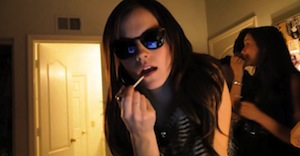 Sofia Coppola makes the emotional range of these characters microscopic. There is no energy in their desire and no remorse in any of their apologies. Boredom is the closest approximation to emotion that this group has, and all of this comes with clear intention. These are characters that perform emotions instead of feeling emotions, because anything interior and unseen is without value.
Sofia Coppola makes the emotional range of these characters microscopic. There is no energy in their desire and no remorse in any of their apologies. Boredom is the closest approximation to emotion that this group has, and all of this comes with clear intention. These are characters that perform emotions instead of feeling emotions, because anything interior and unseen is without value.
Creating emotionally vacant characters is a dangerous choice, because they could (and most likely will) alienate most of the audience. Fortunately the acting is superb. Emma Watson crafts Nicki into a shifting and ambivalent wreck of human being. We are unsure whether to pity her as a product of her surroundings and her upbringing, or despise her as a perpetuator of the cult of fame.
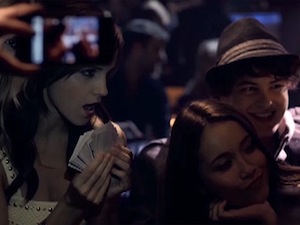
Katie Chang’s Rebecca is an enigma through and through, and Israel Broussard’s Marc is ugly, yet the closest thing we get to a likeable character. Leslie Mann gives a great supporting performance as Nicki’s mother, Laurie, and Taissa Farmiga has one of the most disturbing scenes in the film.
Just because the characters are unlikeable and devoid of emotion, does not mean that Coppola’s film is.
There is a control and craft that comes through in subtle and deliberate ways. The first and most apparent is in the use of music and sound design. As the main title hits the screen, the music is blares. Each of the party and club scenes as the group prepares for or celebrates a burglary is dominated by music, but as the film goes on these moments become smaller and smaller, and the overall soundscape becomes quieter. Coppola is allowing space for thought and introspection from her audience.
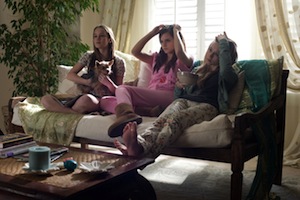 There are three scenes in particular that illustrate this point. The first is a wide-angle shot of Audrina Patridge’s house. From this single shot we watch as Marc and Rebecca enter and move from room to room; the glass house reveals their every activity. While the pair burglarizes the home, the ambient sound becomes distant. We hear everything as if from far away, and it creates a mental space. We are allowed to scrutinize the activity of Rebecca and Marc, and can see it as a home invasion from far away.
There are three scenes in particular that illustrate this point. The first is a wide-angle shot of Audrina Patridge’s house. From this single shot we watch as Marc and Rebecca enter and move from room to room; the glass house reveals their every activity. While the pair burglarizes the home, the ambient sound becomes distant. We hear everything as if from far away, and it creates a mental space. We are allowed to scrutinize the activity of Rebecca and Marc, and can see it as a home invasion from far away.
The next scene occurs in Lindsay Lohan’s house. Rebecca, an avid admirer of Lohan, wears her idol’s jewelry and stares at herself in the mirror. Again the sound seems to come from far off, and it gives us the nearest approximation to any emotion that we will see from Rebecca. This is her Holy Grail, and we can see it for the shallow prize that it is.
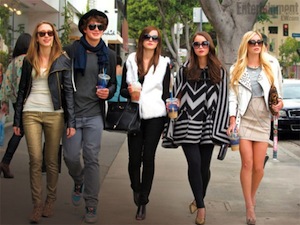 The final scene where Coppola controls her sound design in this way comes as the doors to the courtroom are opened after a verdict has been dispensed. By linking these scenes through sound, Coppola can avoid attaching a moral while at the same time forcing her audience to question the Burglar Bunch’s activities and ponder the cost.
The final scene where Coppola controls her sound design in this way comes as the doors to the courtroom are opened after a verdict has been dispensed. By linking these scenes through sound, Coppola can avoid attaching a moral while at the same time forcing her audience to question the Burglar Bunch’s activities and ponder the cost.
If you need some sort of statement or moral grounding in The Bling Ring, it will be hard to find. I take this as a sign of artistic strength and applaud Sofia Coppola’s choice, but it may trouble many.
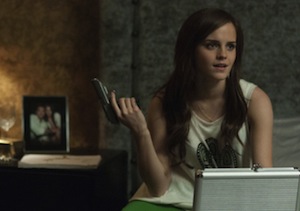 There is one scene that may give some additional insight. Sam comes across a handgun in one of the houses. She begins playing with it and pointing it into Marc’s face. Marc pushes the gun away, but Sam bloodlessly mocks or threatens him all the while pointing the gun back into Marc’s face. The moment is truly upsetting, because we in the audience can see the dire consequences of this carelessness while the characters either cannot or simply don’t give a shit. It made my stomach churn with anxiety.
There is one scene that may give some additional insight. Sam comes across a handgun in one of the houses. She begins playing with it and pointing it into Marc’s face. Marc pushes the gun away, but Sam bloodlessly mocks or threatens him all the while pointing the gun back into Marc’s face. The moment is truly upsetting, because we in the audience can see the dire consequences of this carelessness while the characters either cannot or simply don’t give a shit. It made my stomach churn with anxiety.
And that’s point.
In order to neither condemn nor exalt the Bling Ring or the empty trappings of fame mongers such as Paris Hilton or Lindsay Lohan, Sofia Coppola cannot take a stand. To make a point would allay our anxieties. When we watch the wealthy thieves from the Valley or the source of their temptation, as we watch The Bling Ring, we should be horrified at what we see, and know that there is no end in sight.







Comments on this entry are closed.